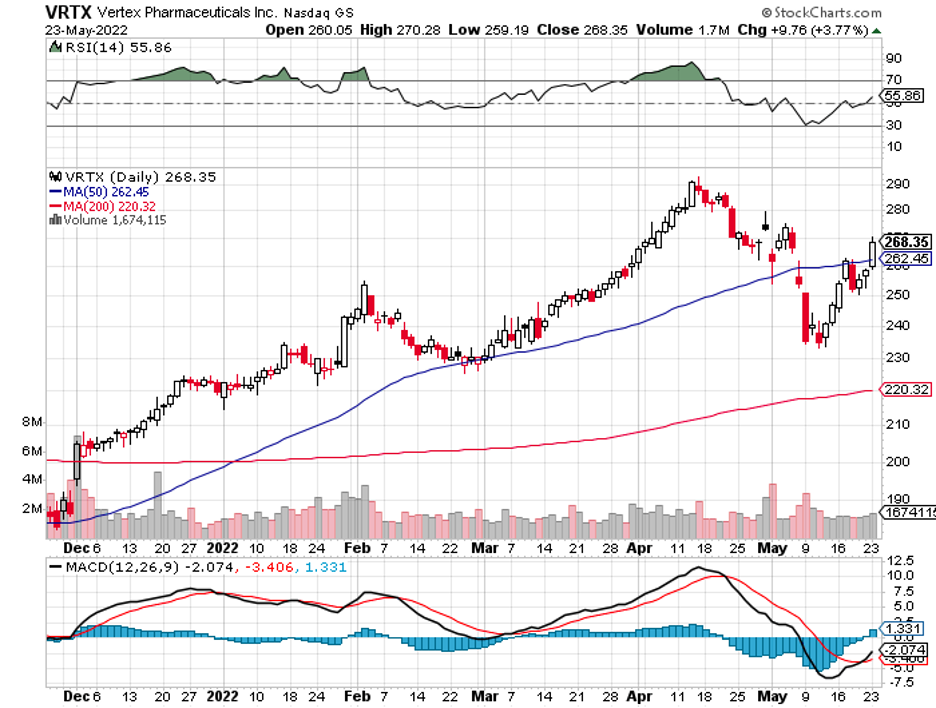When will the turmoil in the stock market come to an end? Unfortunately, nobody can offer a definitive answer.
At this point, there’s still no end in sight to high inflation, climbing interest rates, and the continuing war in Ukraine.
Needless to say, all these issues are affecting the stock market. However, not all stocks are getting negatively affected by the turmoil.
There are still relatively safe bets to buy, with some crushing the market these days.
One of them is Vertex (VRTX).
Vertex stock soared by over 30% year-to-date by mid-April.
While it has given up some of that gain in the past weeks, this biotechnology and healthcare stock is comfortably outperforming the rest of the market, with its shares still up by around 15%.
One reason for Vertex’s good performance is its undisputed monopoly in the cystic fibrosis (CF) market. In fact, its closest potential competitor is AbbVie (ABBV), which recently announced disappointing results for its Phase 2 trials for a CF combo.
This means Vertex’s dominance in the CF space is set to go on for quite some time.
Here’s a bit of background. Vertex has 4 CF treatments.
Among these, the latest treatment, Trikafta, generates the lion’s share of the profits. It raked in $1.7 billion in the first quarter of 2022 alone, with the total revenue for the entire CF pipeline recording $2 billion.
Considering its approved indications and potential approvals, Trikafta is anticipated to treat 90% of the entire CF patient population.
Looking at its current performance and how strong its hold is in the CF market, it appears that Vertex’s prediction that it can sustain its dominance in this segment until at least the late 2030s will be proven right.
Moreover, it’s evident that Trikafta has yet to reach its peak revenue. However, Vertex isn’t depending on this particular treatment alone.
Rather, the company is working on developing a worthy competitor to this top-selling treatment.
That is, Vertex is working on a CF candidate that may potentially be even more effective than Trikafta.
So far, this new drug candidate not only has the capacity to beat Trikafta in terms of efficacy but also offers a more convenient option.
Trikafta is a twice-a-day oral drug that comes in the form of 3 tablets. Meanwhile, this potential competitor is a once-a-day alternative.
If everything goes according to plan, the Phase 3 trial for this Trikafta challenger could start by the end of 2022 or early 2023.
This means that the closest potential rival for the company’s top-selling treatment is its own candidate.
Apart from this, Vertex is working with Moderna (MRNA) to come up with an mRNA therapy for CF patients.
The goal is to offer an alternative option to patients who are not eligible for the current CF therapies.
Although this continued dominance in the CF sector is already a good enough reason to buy Vertex shares, they may be an even better one.
To date, Vertex has at least 6 programs queued in mid to late-stage clinical studies, all of which are projected to become multi-billion dollar revenue streams.
Outside its CF segment, Vertex could have another big winner in the form of gene-editing treatment CTX001.
This is a treatment for sickle cell disease and transfusion-dependent beta-thalassemia that the company has been working on with CRISPR Therapeutics (CRSP).
While CTX001 is promising, it won’t be entering the gene therapy market without any competition. It has to battle the likes of Editas (EDIT), Beam Therapeutics (BEAM), and Intellia (NTLA).
Nonetheless, CTX001, if approved, is a game-changer because it is developed as a one-time cure for genetic blood disorders.
So far, trial results have been positive, and the collaborating duo is expected to file for regulatory approval by the end of 2022 and possibly launch the product by the first half of 2023.
This gene-editing therapy is a significant milestone for Vertex, with CTX001 expected to become another blockbuster, raking in roughly $1 billion in annual sales for the company even after giving CRISPR its share of the profits.
Recently, Vertex added another $900 million to its collaboration with CRISPR to boost its share from 50% to 60%, indicating that it values CTX001 at roughly $10 billion.
Other critical treatments outside the CF space are VX548, an opioid alternative targeting acute pain, and VX800, a stem cell-derived therapy developed to treat Type 1 diabetes.
Vertex has been accused as a company scared of getting out of its comfort zone for quite some time.
With these new ventures, Vertex has become something of a pioneer—a strategy that is projected to open long-term and lucrative revenue streams for the company.
Overall, all these efforts paint an obvious picture. That is, Vertex is a well-balanced company with a main business that capably and reliably generates billions and is complemented by an exciting pipeline that holds the potential to replicate the success of its already established portfolio.

